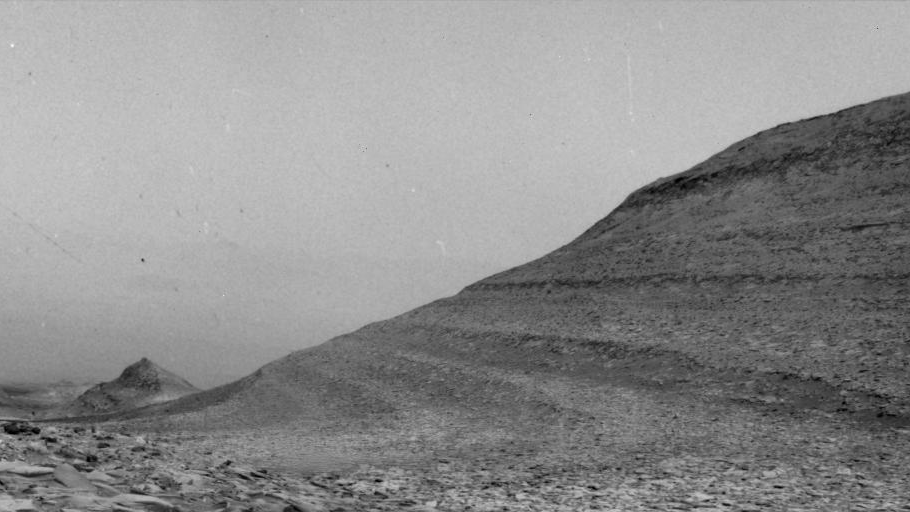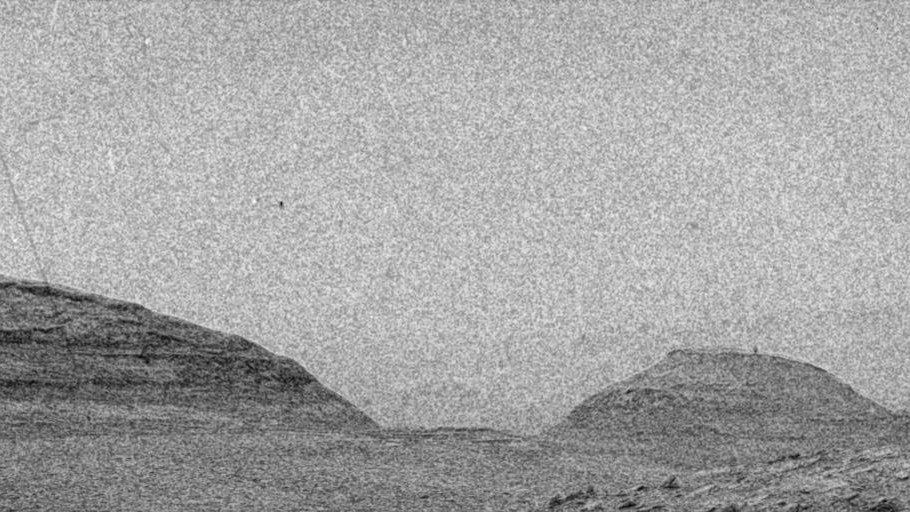13.06.2024
The radiation dose on the surface of mars jumped up to the equivalent of receiving 30 chest X-rays all in one go.

The specks in the sequence of images in this video were caused by charged particles from a solar storm hitting one of the navigation cameras aboard NASA's Curiosity Mars rover. The mission uses the rover's navigation cameras to try capturing images of dust devils (dust-bearing whirlwinds) and wind gusts, like the gust seen here. (Image credit: NASA/JPL-Caltech)
The solar storms that gave rise to the hugely impressive auroras seen around the world on May 10 also gave Mars a lashing, sparking auroras over the Red Planet and dousing the surface with harmful radiation.
The primary source of the solar storms was an active region, AR3664, which was an intense knot of magnetic flux on the sun populated by dozens of sunspotsthat unleashed a large number of powerful flares and coronal mass ejections (CMEs) first at us, and then later as it rotated around the sun, towards Mars.
The most powerful flare unleashed during this period occurred on May 20, 2024, when Earth was on the other side of the sun but Mars was directly in the firing line. A barrage of gamma-rays and X-rays flew towards Mars at the speed of light, followed a few days later by the slower-moving charged particles of a coronal mass ejection.
On the surface, in Mars' Gale crater, the Curiosity Mars rover's Radiation Assessment Detector (RAD) usually records an average daily radiation dose of about 700 micrograys. During the solar storm, the radiation detected by RAD shot up to 8,100 micrograys, which is the equivalent of undergoing about 30 chest X-rays all at once.
While still a long way short of being instantly fatal, experiencing such exposure on multiple occasions during any prolonged stay on the planet would drastically increase health risks. On the other hand, it was the largest blast of radiation that RAD had detected since Curiosity landed on Mars 12 years ago, so doses that are quite so high are not the norm.
Astronauts could potentially take shelter in caves like those possibly connected with the pit craters and lava tubes on the flanks of volcanoes, such as the pit that was doing the rounds recently in an image circulated from NASA's Mars Reconnaissance Orbiter.
The Southwest Research Institute's Don Hassler, who is the principal investigator on RAD, agrees with this safety measure.
"Cliff-sides or lava tubes would provide additional shielding for an astronaut from such an event," he said in a statement. However, it's not possible for everyone to hide in a cave, particularly if you're not actually on the planet. "In Mars orbit or deep space, the does rate would be significantly higher."

NASA's Curiosity Mars rover captured evidence of a solar storm's charged particles arriving at the Martian surface in this three-frame video taken by one of the rover's navigation cameras on May 20, 2024, the 4,190th Martian day, or sol, of the mission. (Image credit: NASA/JPL-Caltech)
Indeed it was. The radiation was so high that it knocked out the orbiting Mars Odyssey spacecraft's main star-finding camera that it uses for orienting itself. Although the camera came back online after one hour, it was a reminder that spacecraft are vulnerable to solar radiation. Back in October 2003, Mars Odyssey's radiation detector was fried by radiation from one of the largest solar flares in living memory.
Another Mars-orbiting spacecraft, MAVEN (Mars Atmosphere and Volatile EvolutioN) fared better, and was able to capture Martian aurora from above Mars as charged particles from the CME rained down onto the Red Planet.
MAVEN was able to image the aurora on Mars from high overhead, as well as pick up a host of charged particles with its Solar Energetic Particle instrument. On the ground, black and white images taken by Curiosity's navigation camera (Navcam) crackled with 'snow' — white flecks and streaks caused by energetic particles striking the camera sensor.
"This was the largest solar energetic particle event that MAVEN has ever seen," said Christina Lee of the University of California. Lee is the Space Weather Lead on the MAVEN team. "There have been several solar events in the past weeks, so we were seeing wave after wave of particles hitting Mars."
Indeed, it seems like the entirety of the solar system took a bashing from the sun in May as its active regions spewed particles and radiation in all directions. The auroras seen on Earth and Mars may also have just been a taste of things to come — with the sun's cycle of activity approaching maximum in July 2025, we can expect many more solar storms throughout the coming months, and the effects will be visible to us on an interplanetary scale.
On Earth we have two things to protect us from this radiation onslaught, namely our planet's global magnetic field and thick atmosphere, which can deflect and absorb the radiation, respectively.
Mars, however, lacks a global magnetic field, although it does have localized magnetic pockets, believed to be remnants of an ancient planetary field. The Martian atmosphere is also relatively sparse compared to Earth's. Combined, this means the red planet bears the full brunt of a solar storm.
Earth's magnetic field is streamlined into a teardrop shape, called the magnetotail, by the solar wind. When a CME strikes, charged particles become trapped in the magnetotail, which acts as a kind of solar-wind sock. The pressure from the CME pinches the magnetotail off, separating it from Earth's magnetic field. As the magnetotail is carried away from us by the solar wind (don't worry, like a salamander regrowing a lost limb, Earth regrows its magnetotail) the charged particles that were trapped in it are free to follow magnetic field lines down to the magnetic poles.
On the way the charged particles bump into atmospheric molecules, primarily oxygen, nitrogen and hydrogen, causing those molecules to glow the colors of the aurora — green, red, blue respectively. This is why we tend to see auroras closer to the poles and not the equator.
On Mars there is no magnetic field to catch charged particles and funnel them to the poles, so when a CME hits, the charged particles just seep directly into the atmosphere all over the planet. Because Mars does have some molecular oxygen in its atmosphere, its auroras tend to be tinted green.
Quelle: SC
